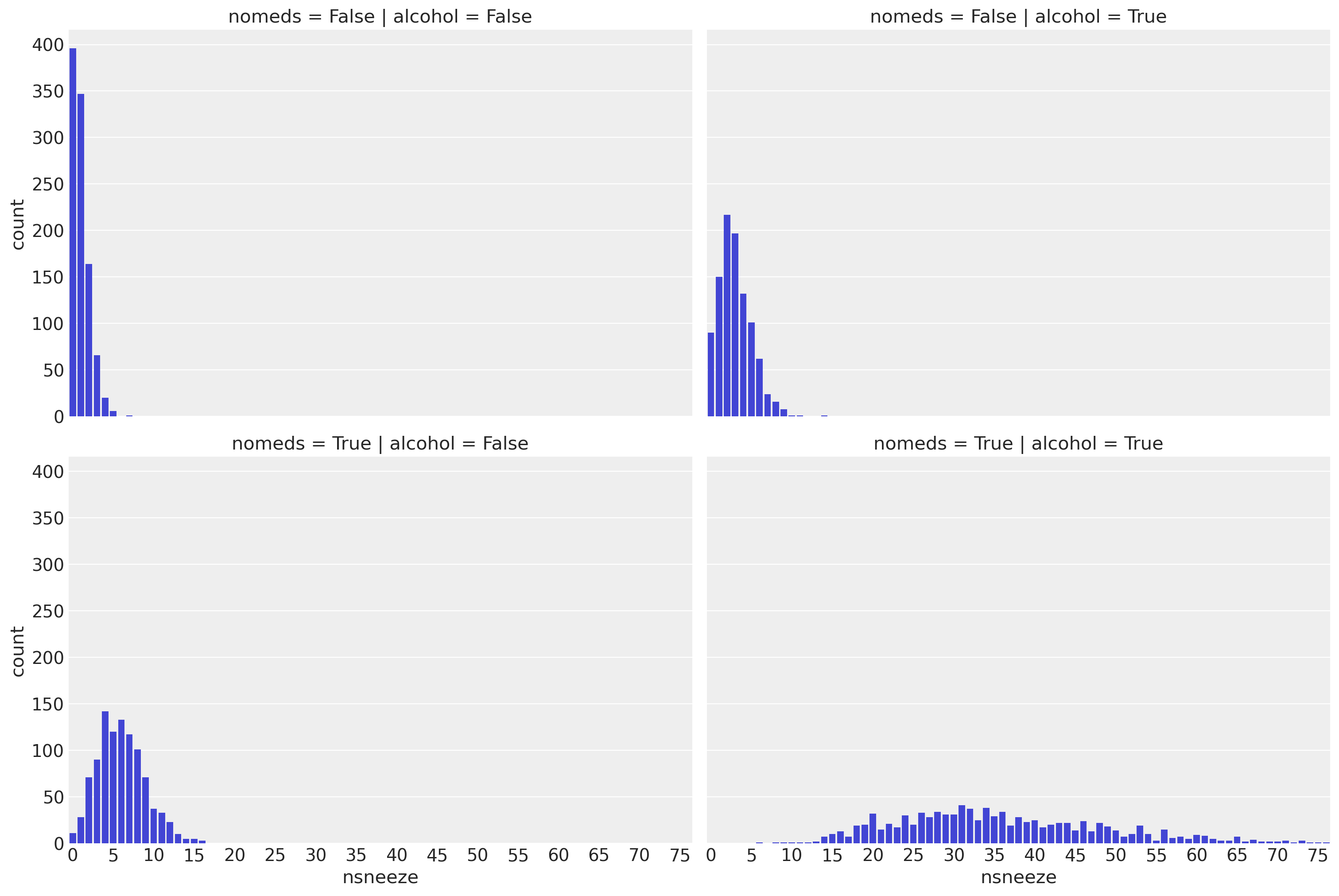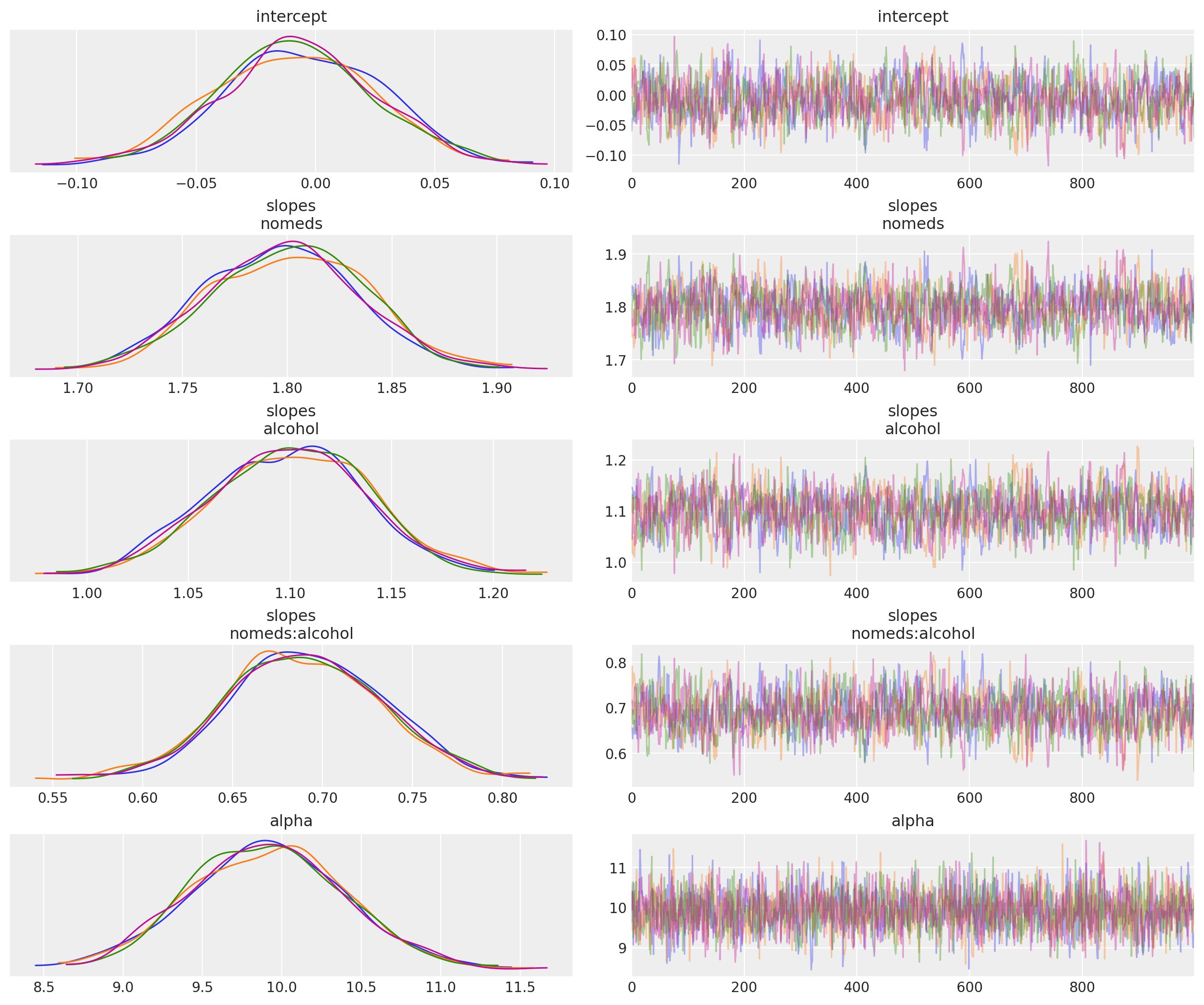GLM: Negative Binomial Regression#
Attention
This notebook uses libraries that are not PyMC dependencies and therefore need to be installed specifically to run this notebook. Open the dropdown below for extra guidance.
Extra dependencies install instructions
In order to run this notebook (either locally or on binder) you won’t only need a working PyMC installation with all optional dependencies, but also to install some extra dependencies. For advise on installing PyMC itself, please refer to Installation
You can install these dependencies with your preferred package manager, we provide as an example the pip and conda commands below.
$ pip install seaborn
Note that if you want (or need) to install the packages from inside the notebook instead of the command line, you can install the packages by running a variation of the pip command:
import sys
!{sys.executable} -m pip install seaborn
You should not run !pip install as it might install the package in a different
environment and not be available from the Jupyter notebook even if installed.
Another alternative is using conda instead:
$ conda install seaborn
when installing scientific python packages with conda, we recommend using conda forge
RANDOM_SEED = 8927
rng = np.random.default_rng(RANDOM_SEED)
%config InlineBackend.figure_format = "retina"
az.style.use("arviz-darkgrid")
This notebook closely follows the GLM Poisson regression example by Jonathan Sedar (which is in turn inspired by a project by Ian Osvald) except the data here is negative binomially distributed instead of Poisson distributed.
Negative binomial regression is used to model count data for which the variance is higher than the mean. The negative binomial distribution can be thought of as a Poisson distribution whose rate parameter is gamma distributed, so that rate parameter can be adjusted to account for the increased variance.
Generate Data#
As in the Poisson regression example, we assume that sneezing occurs at some baseline rate, and that consuming alcohol, not taking antihistamines, or doing both, increase its frequency.
Poisson Data#
First, let’s look at some Poisson distributed data from the Poisson regression example.
# Mean Poisson values
theta_noalcohol_meds = 1 # no alcohol, took an antihist
theta_alcohol_meds = 3 # alcohol, took an antihist
theta_noalcohol_nomeds = 6 # no alcohol, no antihist
theta_alcohol_nomeds = 36 # alcohol, no antihist
# Create samples
q = 1000
df_pois = pd.DataFrame(
{
"nsneeze": np.concatenate(
(
rng.poisson(theta_noalcohol_meds, q),
rng.poisson(theta_alcohol_meds, q),
rng.poisson(theta_noalcohol_nomeds, q),
rng.poisson(theta_alcohol_nomeds, q),
)
),
"alcohol": np.concatenate(
(
np.repeat(False, q),
np.repeat(True, q),
np.repeat(False, q),
np.repeat(True, q),
)
),
"nomeds": np.concatenate(
(
np.repeat(False, q),
np.repeat(False, q),
np.repeat(True, q),
np.repeat(True, q),
)
),
}
)
df_pois.groupby(["nomeds", "alcohol"])["nsneeze"].agg(["mean", "var"])
| mean | var | ||
|---|---|---|---|
| nomeds | alcohol | ||
| False | False | 1.047 | 1.127919 |
| True | 2.986 | 2.960765 | |
| True | False | 5.981 | 6.218858 |
| True | 35.929 | 36.064023 |
Since the mean and variance of a Poisson distributed random variable are equal, the sample means and variances are very close.
Negative Binomial Data#
Now, suppose every subject in the dataset had the flu, increasing the variance of their sneezing (and causing an unfortunate few to sneeze over 70 times a day). If the mean number of sneezes stays the same but variance increases, the data might follow a negative binomial distribution.
# Gamma shape parameter
alpha = 10
def get_nb_vals(mu, alpha, size):
"""Generate negative binomially distributed samples by
drawing a sample from a gamma distribution with mean `mu` and
shape parameter `alpha', then drawing from a Poisson
distribution whose rate parameter is given by the sampled
gamma variable.
"""
g = stats.gamma.rvs(alpha, scale=mu / alpha, size=size)
return stats.poisson.rvs(g)
# Create samples
n = 1000
df = pd.DataFrame(
{
"nsneeze": np.concatenate(
(
get_nb_vals(theta_noalcohol_meds, alpha, n),
get_nb_vals(theta_alcohol_meds, alpha, n),
get_nb_vals(theta_noalcohol_nomeds, alpha, n),
get_nb_vals(theta_alcohol_nomeds, alpha, n),
)
),
"alcohol": np.concatenate(
(
np.repeat(False, n),
np.repeat(True, n),
np.repeat(False, n),
np.repeat(True, n),
)
),
"nomeds": np.concatenate(
(
np.repeat(False, n),
np.repeat(False, n),
np.repeat(True, n),
np.repeat(True, n),
)
),
}
)
df
| nsneeze | alcohol | nomeds | |
|---|---|---|---|
| 0 | 2 | False | False |
| 1 | 1 | False | False |
| 2 | 2 | False | False |
| 3 | 2 | False | False |
| 4 | 3 | False | False |
| ... | ... | ... | ... |
| 3995 | 28 | True | True |
| 3996 | 63 | True | True |
| 3997 | 19 | True | True |
| 3998 | 34 | True | True |
| 3999 | 40 | True | True |
4000 rows × 3 columns
df.groupby(["nomeds", "alcohol"])["nsneeze"].agg(["mean", "var"])
| mean | var | ||
|---|---|---|---|
| nomeds | alcohol | ||
| False | False | 0.990 | 1.137037 |
| True | 2.983 | 4.030742 | |
| True | False | 6.004 | 8.658643 |
| True | 35.918 | 169.018294 |
As in the Poisson regression example, we see that drinking alcohol and/or not taking antihistamines increase the sneezing rate to varying degrees. Unlike in that example, for each combination of alcohol and nomeds, the variance of nsneeze is higher than the mean. This suggests that a Poisson distribution would be a poor fit for the data since the mean and variance of a Poisson distribution are equal.
Visualize the Data#
g = sns.catplot(x="nsneeze", row="nomeds", col="alcohol", data=df, kind="count", aspect=1.5)
# Make x-axis ticklabels less crowded
ax = g.axes[1, 0]
labels = range(len(ax.get_xticklabels(which="both")))
ax.set_xticks(labels[::5])
ax.set_xticklabels(labels[::5]);
/opt/homebrew/Caskroom/miniconda/base/envs/pymc-dev/lib/python3.11/site-packages/seaborn/axisgrid.py:123: UserWarning: The figure layout has changed to tight
self._figure.tight_layout(*args, **kwargs)
/opt/homebrew/Caskroom/miniconda/base/envs/pymc-dev/lib/python3.11/site-packages/seaborn/axisgrid.py:123: UserWarning: The figure layout has changed to tight
self._figure.tight_layout(*args, **kwargs)

Negative Binomial Regression#
Create GLM Model#
COORDS = {"regressor": ["nomeds", "alcohol", "nomeds:alcohol"], "obs_idx": df.index}
with pm.Model(coords=COORDS) as m_sneeze_inter:
a = pm.Normal("intercept", mu=0, sigma=5)
b = pm.Normal("slopes", mu=0, sigma=1, dims="regressor")
alpha = pm.Exponential("alpha", 0.5)
M = pm.ConstantData("nomeds", df.nomeds.to_numpy(), dims="obs_idx")
A = pm.ConstantData("alcohol", df.alcohol.to_numpy(), dims="obs_idx")
S = pm.ConstantData("nsneeze", df.nsneeze.to_numpy(), dims="obs_idx")
λ = pm.math.exp(a + b[0] * M + b[1] * A + b[2] * M * A)
y = pm.NegativeBinomial("y", mu=λ, alpha=alpha, observed=S, dims="obs_idx")
idata = pm.sample()
Auto-assigning NUTS sampler...
Initializing NUTS using jitter+adapt_diag...
Multiprocess sampling (4 chains in 4 jobs)
NUTS: [intercept, slopes, alpha]
Sampling 4 chains for 1_000 tune and 1_000 draw iterations (4_000 + 4_000 draws total) took 11 seconds.
View Results#
az.plot_trace(idata, compact=False);

# Transform coefficients to recover parameter values
az.summary(np.exp(idata.posterior), kind="stats", var_names=["intercept", "slopes"])
| mean | sd | hdi_3% | hdi_97% | |
|---|---|---|---|---|
| intercept | 0.993 | 0.033 | 0.935 | 1.056 |
| slopes[nomeds] | 6.048 | 0.221 | 5.635 | 6.438 |
| slopes[alcohol] | 3.006 | 0.115 | 2.789 | 3.215 |
| slopes[nomeds:alcohol] | 1.995 | 0.086 | 1.842 | 2.163 |
az.summary(idata.posterior, kind="stats", var_names="alpha")
| mean | sd | hdi_3% | hdi_97% | |
|---|---|---|---|---|
| alpha | 9.909 | 0.487 | 9.05 | 10.887 |
The mean values are close to the values we specified when generating the data:
The base rate is a constant 1.
Drinking alcohol triples the base rate.
Not taking antihistamines increases the base rate by 6 times.
Drinking alcohol and not taking antihistamines doubles the rate that would be expected if their rates were independent. If they were independent, then doing both would increase the base rate by 3*6=18 times, but instead the base rate is increased by 3*6*2=36 times.
Finally, the mean of nsneeze_alpha is also quite close to its actual value of 10.
See also, bambi's negative binomial example for further reference.
License notice#
All the notebooks in this example gallery are provided under the MIT License which allows modification, and redistribution for any use provided the copyright and license notices are preserved.
Citing PyMC examples#
To cite this notebook, use the DOI provided by Zenodo for the pymc-examples repository.
Important
Many notebooks are adapted from other sources: blogs, books… In such cases you should cite the original source as well.
Also remember to cite the relevant libraries used by your code.
Here is an citation template in bibtex:
@incollection{citekey,
author = "<notebook authors, see above>",
title = "<notebook title>",
editor = "PyMC Team",
booktitle = "PyMC examples",
doi = "10.5281/zenodo.5654871"
}
which once rendered could look like: